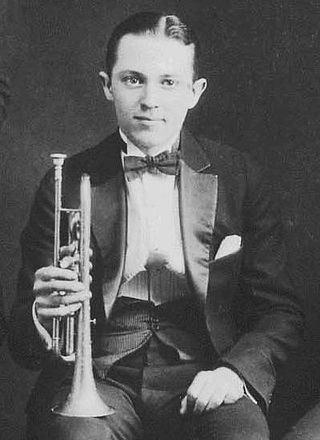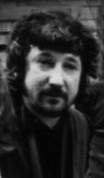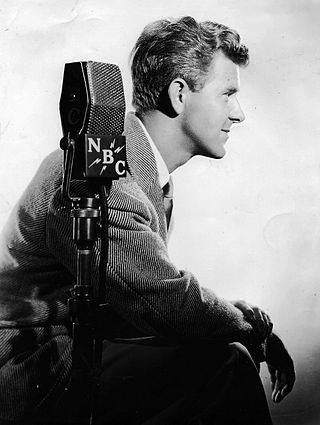
The flugelhorn, also spelled fluegelhorn, flugel horn, or flügelhorn, is a brass instrument that resembles the trumpet and cornet, but has a wider, more conical bore. Like trumpets and cornets, most flugelhorns are pitched in B♭, though some are in C. It is a type of valved bugle, developed in Germany in the early 19th century from a traditional English valveless bugle. The first version of a valved bugle was sold by Heinrich Stölzel in Berlin in 1828. The valved bugle provided Adolphe Sax with the inspiration for his B♭ soprano (contralto) saxhorns, on which the modern-day flugelhorn is modelled.

Louis Daniel Armstrong, nicknamed "Satchmo", "Satch", and "Pops", was an American trumpeter and vocalist. He was among the most influential figures in jazz. His career spanned five decades and several eras in the history of jazz. Armstrong received numerous accolades including the Grammy Award for Best Male Vocal Performance for Hello, Dolly! in 1965, as well as a posthumous win for the Grammy Lifetime Achievement Award in 1972. His influence crossed musical genres, with inductions into the DownBeat Jazz Hall of Fame, the Rock and Roll Hall of Fame, and the National Rhythm & Blues Hall of Fame, among others.

Leon Bismark "Bix" Beiderbecke was an American jazz cornetist, pianist and composer.

Hoagland Howard Carmichael was an American musician, composer, songwriter, actor, author and lawyer. Carmichael was one of the most successful Tin Pan Alley songwriters of the 1930s and 1940s, and was among the first singer-songwriters in the age of mass media to utilize new communication technologies such as old-time radio broadcasts, television, microphones, and sound recordings.

"Stardust" is a 1927 song composed by Hoagy Carmichael, with lyrics later added by Mitchell Parish. It has been recorded as an instrumental or vocal track over 1,500 times. Carmichael developed a taste for jazz while attending Indiana University. He formed his own band and played at local events in Indiana and Ohio. Following his graduation, Carmichael moved to Florida to work for a law firm. He left the law sector and returned to Indiana, after learning of the success of one of his compositions. In 1927, after leaving a local university hangout, Carmichael started to whistle a tune that he later developed further. When composing the song, he was inspired by the end of one of his love affairs, and on the suggestion of a university classmate, he decided on its title. The same year, Carmichael recorded an instrumental version of the song for Gennett Records.
Jazz standards are musical compositions that are an important part of the musical repertoire of jazz musicians, in that they are widely known, performed, and recorded by jazz musicians, and widely known by listeners. There is no definitive list of jazz standards, and the list of songs deemed to be standards changes over time. Songs included in major fake book publications and jazz reference works offer a rough guide to which songs are considered standards.

Clark Virgil Terry Jr. was an American swing and bebop trumpeter, a pioneer of the flugelhorn in jazz, and a composer and educator.

James Wesley "Bubber" Miley was an American early jazz trumpet and cornet player, specializing in the use of the plunger mute.
Larry Don Austin was an American composer noted for his electronic and computer music works. He was a co-founder and editor of the avant-garde music periodical Source: Music of the Avant Garde. Austin gained additional international recognition when he realized a completion of Charles Ives's Universe Symphony. Austin served as the president of the International Computer Music Association (ICMA) from 1990 to 1994 and served on the board of directors of the ICMA from 1984 to 1988 and from 1990 to 1998.

Wallace Roney was an American jazz trumpeter. He has won one Grammy award and has two nominations.
James George Hunter, known professionally as Jimmy Rowles, was an American jazz pianist, vocalist, and composer. As a bandleader and accompanist, he explored multiple styles including swing and cool jazz.
"Skylark" is an American popular song with lyrics by Johnny Mercer (1909-1976), and music by Hoagy Carmichael (1899-1981), published in 1941.

Richard Edwin Morrissey was a British jazz musician and composer. He played the tenor saxophone, soprano saxophone and flute.
John Livingston Eaton is an American pianist, musicologist, humorist, educator and interpreter of jazz and American popular music. He is "considered one of the foremost interpreters of American music."
Ray Linn was an American jazz trumpeter.
Daryl Runswick is a classically trained English composer, arranger, jazz musician, producer and educationalist.
The Stark Reality was an American jazz-rock band which recorded the two-disc 1970 album The Stark Reality Discovers Hoagy Carmichael's Music Shop, a heavily improvised reinvention of a 1958 children's album by songwriter Hoagy Carmichael to be used for the show Hoagy Carmichael's Music Shop which aired on PBS.

Bix is a 1991 Italian drama film directed by Pupi Avati and starring Bryant Weeks. The plot is about the final years of cornet player Bix Beiderbecke. It was an Official Selection premiering at the 1991 Cannes Film Festival.

The period from the end of the First World War until the start of the Depression in 1929 is known as the "Jazz Age". Jazz had become popular music in America, although older generations considered the music immoral and threatening to cultural values. Dances such as the Charleston and the Black Bottom were very popular during the period, and jazz bands typically consisted of seven to twelve musicians. Important orchestras in New York were led by Fletcher Henderson, Paul Whiteman and Duke Ellington. Many New Orleans jazzmen had moved to Chicago during the late 1910s in search of employment; among others, the New Orleans Rhythm Kings, King Oliver's Creole Jazz Band and Jelly Roll Morton recorded in the city. However, Chicago's importance as a center of jazz music started to diminish toward the end of the 1920s in favor of New York.

Charles "Bud" Dant was an American musician, arranger and composer. In the 1930s, he attended and graduated Indiana University's School of Music. Jazz composer Hoagy Carmichael had persuaded Dant—who at that time had his own "Bud Dant Collegians" danceband—to come to IU to study at their School of Music. At that time, Carmichael did not know how to read or write music. The two friends met one day in 1927 at the school's Book Nook restaurant, where Carmichael played the first several bars of a song he had conceived—a jazz chorus. He asked Dant to write an arrangement right there in the Book Nook restaurant—this was the first time the song Stardust, which at the time was called "Star Dust," had ever been written down. According to Dant, the piece was originally a peppy jazz song and recorded in 1927, but in 1928, a slower version was written out by Dant and Carmichael. The piece was recorded with Carmichael and others at the Gennett Records studio in Richmond, Indiana. In 1929, Mitchell Parish wrote lyrics to the song. Stardust, an idiosyncratic melody in medium tempo, became an American standard, and is one of the most recorded songs of the 20th century, with over 1,500 total recordings.











